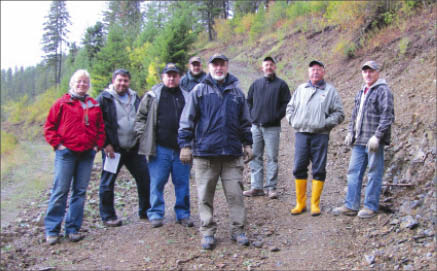Newfoundland-focused explorer Marathon Gold (MOZ-T) is ramping up its U.S. presence with a 20,000-metre drill program at its Golden Chest gold mine project in Idaho and a historic Bonanza gold mine acquisition across the state line in Oregon.
At the historic Golden Chest mine property in the prolific Coeur d’Alene mining district, Marathon expects to release a National Instrument 43-101-compliant resource this quarter following 10,000 metres of drilling last year.
The mine hosts historic resources from New Jersey Mining — from which Marathon has already earned a 50% stake in the property, and can earn 10% more by spending $3.5-million — and from work completed by Newmont Exploration in the eighties.
New Jersey Mining began exploring the property in 2003 and, as of late 2010, had established a non-43-101 but U.S. Securities and Exchange Commission-compliant underground resource of 242,000 measured and indicated tonnes, grading 5.1 grams gold for 38,000 contained oz. gold. Newmont’s work established a non-compliant open-pit resource of 1.2 million measured and indicated tonnes grading 1.35 grams gold per tonne and 5.5 million inferred tonnes grading 0.98 gram gold.
Highlights from Marathon’s drilling last year include hole 34, which hit 22 metres grading 5.07 grams gold from 26 metres depth; hole 33, which cut 20 metres of 3 grams gold from 22 metres downhole; and hole 39, which returned 29 metres of 1.94 grams gold from 3 metres downhole — all reported as true widths. The holes were designed for incorporation into the upcoming resource estimate targeting the hillside mineralization’s open-pit potential.
Most recently the company discovered an underground quartz vein at Golden Chest that returned 1 true-width metre at 29.4 grams gold. The vein, in the northern end of the old mine, sits 12 metres from the existing mine ramp.
The company’s 2012 exploration program will use two surface drill rigs to push the deposit’s open-pit potential farther north.
The Golden Chest property spans 5.2 sq. km over 24 patented and 70 unpatented mining claims and is permitted for drilling, underground mining and tailings storage. Gold at the project is associated with the Idaho thrust fault, with most of the veins hosted in a quartzitic unit while an overlying unit consists of an argillite-siltite sequence of rocks.
In northeastern Oregon, Marathon secured full ownership of the Bonanza mine from Gazelle Land and Timber in December. The mine sits in the historic Greenhorn gold district and has seen little modern exploration. The property spans 13 patented lode claims and one patented parcel covering 1.21 sq. km. Marathon paid 300,000 shares and US$125,000 for the mine, while Gazelle keeps a 2% net smelter return royalty.
Historic reports show the mine produced almost 100,000 oz. gold in the late 1800s from 128,500 tons of ore grading 1.2 oz. per ton. Recovery was 65% with some gold apparently tied up in sulphides that were difficult to separate.
The mine hosts three main veins, with the Bonanza vein traceable for more than 760 metres on surface. Marathon plans to explore the property in the next quarter.
At its flagship Valentine Lake gold property in central Newfoundland, Marathon is ramping up exploration work. The project, which saw 25,250 metres of drilling in 2011, should see another 40,000 metres of drilling this year.
Like at Golden Chest, Marathon expects to have an open-pit resource on the Leprechaun deposit at Valentine Lake soon. The target hosts a measured and indicated resource of 3.3 million tonnes at 2.6 grams gold for 277,000 oz. gold, plus 4.4 million inferred tonnes at 2 grams gold for 285,000 oz. gold.
Marathon is advancing the Leprechaun deposit with its fifty-fifty joint venture partner Mountain Lake Resources (MOA-V).
Elsewhere on the island, Marathon holds a 100% interest in the Finger Pond and Baie Verte gold and base metal properties.
The company came about as a spin out in late 2010 from Stillwater Mining’s (SWC-N) takeover of Marathon’s parent company Marathon PGM, with Stillwater still controlling 15% of Marathon. The junior is led by president and CEO Phillip Walford, who has some 40 years of experience in the mining industry throughout the Americas.
In late 2011 Marathon completed a $10-million financing, selling just under 4 million units at $1.40 each, plus 2.7 million flow-through shares at $1.65 each. The company has 30 million shares outstanding, plus almost 5 million warrants and options between $1.61 and $1.80.
The company’s share price recently closed at 93¢, down from a strong recovery in October to almost $1.70 following several high-grade hits at Leprechaun.


Be the first to comment on "Marathon Gold goes the distance in Idaho, Newfoundland"